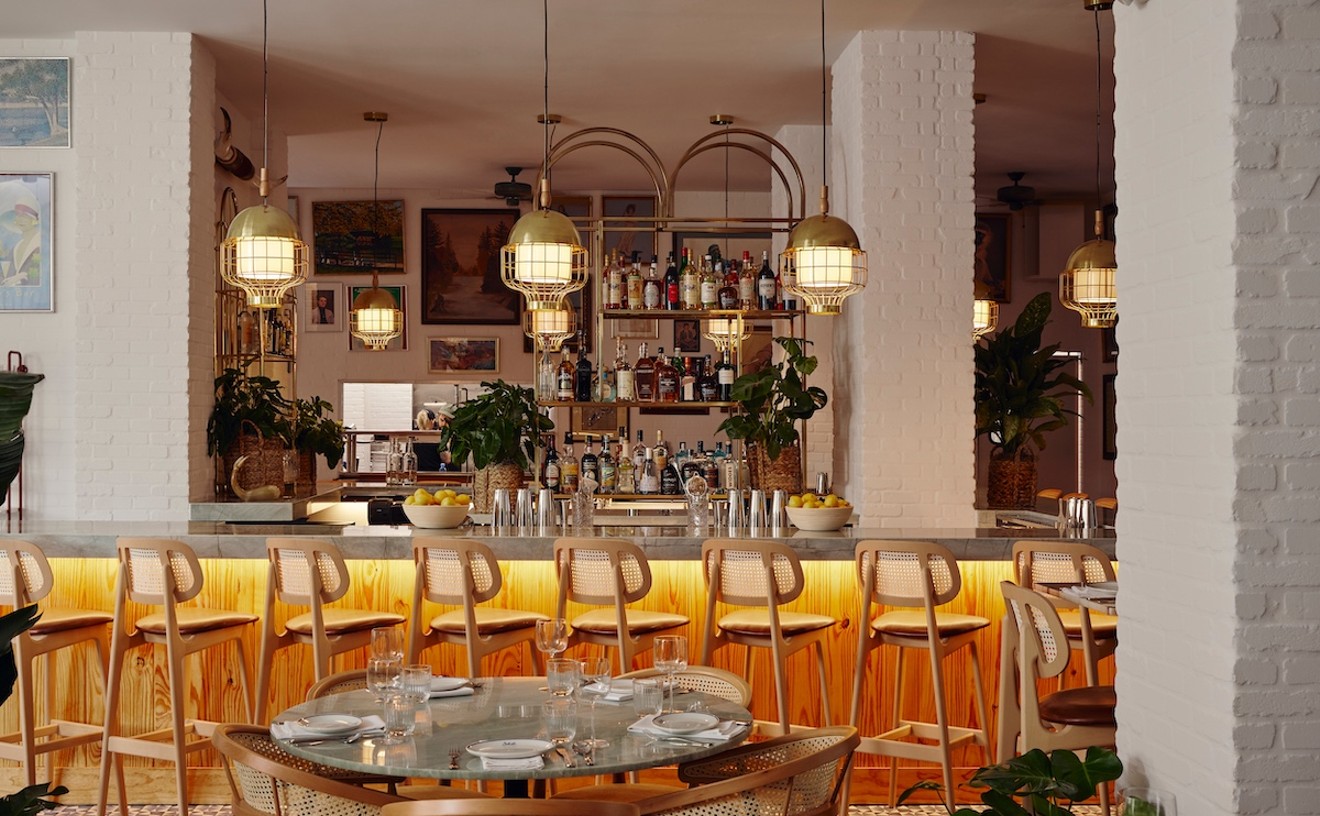Doug Rodriguez is Miami's local boy who made good. During his heyday, he pioneered nuevo Latino cuisine at YUCA in Coral Gables (1989); operated the hugely successful Patria along with other hit venues in New York (1994); and won all sorts of recognition. He was even named one of Newsweek's "100 Americans who will influence the coming millennium"(2000). His OLA restaurant in Miami Beach in 2004 marked a comeback and a return home for Rodriguez, who followed it up five years later with D. Rodriguez Cuba at Hotel Astor. That establishment doesn't impress as much as OLA, but still reflects the chef's culinary chops.
De Rodriguez Ocean, Doug's newest restaurant, seems more like a business plan than a place to dine: a big-name chef on the marquee, an emphasis on seafood (which the Beach lacks), and a means of snatching some lucrative tourist trade from the real estate south of Fifth Street that belongs to Prime 112 and Prime Italian. Perhaps most importantly, the menu of raw bar items, ceviches, and ten straightforward entrées was apparently composed so that it could be prepared without needing Mr. Rodriguez on deck. If the restaurant had paid attention to food, service, and ambiance as much as scheming to cash in, it might have worked.
You can't actually see the ocean from De Rodriguez Ocean — at least not at night — but outdoor tables at the Bentley Hotel look upon a swimming pool that glows in ever-changing hues. The interior design seems to have been thrown together using items purchased at garage sales and Target. The restaurant is a little reminiscent of The Cape Cod Room, Ken Lyon's now-sunk attempt at absentee management of a hotel seafood restaurant. If that space looked like a 1960s New England Holiday Inn dining room, Doug Rodriguez's looks like that of a 1970s New England Marriott. Two of the walls are floor-to-ceiling glass, another is backed by a seven-seat ceviche/raw bar framed by illuminated marble. Behind the bar are fairly barren shelves and a blackboard with nothing written on it (powdered eraser tracks suggest it's occasionally used). Some nautical knickknacks adorn the space, and 19 bars of red light incongruously line a dark wooden ceiling. Comfortably cushioned seats surround dark wooden tables; Red votive candles, glassware, flatware, and salt/pepper shakers culled from the low-end pages of a Sysco catalogue sit atop. Dinner here is an expensive proposition — ceviches $13 to $23, appetizers $10 to $18, salads $12 to $14, fish entrées $26 to $34, the only soup $15 (lobster bisque), and desserts $9 — too pricey for such tacky table trappings. I imagine that an honest hotel concierge, upon being pressed by a guest as to what differentiates this D-Rod establishment from the highly attractive OLA and Cuba restaurants, might respond that Ocean is the ugly one.
Ceviches, on the other hand, are lovely — these have always been a Rodriguez strength. Divided into mixtos and tiraditos, each of the ten selections is creatively composed and sparkling in flavor and freshness. A favorite featured slices of lime-and-grapefruit-marinated, organic Peruvian blue tilapia (farm-raised and sweeter, it was better than regular tilapia) garnished with pink grapefruit sections, mint, jalapeños, and just a bit of candied grapefruit to offset the tartness. We also enjoyed cubes of bigeye tuna tossed with equal-sized squares of compressed watermelon tastily tossed with kumquat, yuzu, basil, and tarragon. A Maine lobster mixto seemed more like a Thai-style salad. A generous amount of crustacean was piled high and plied with coconut water, lemon grass, ginger, kaffir lime, Thai chili, and cilantro (Why Thai in a Latin eatery? Not sure). It would have been just fine as it was, but a sizable scoop of disconcertingly sweet and cold coconut sorbet crowned and drowned the composition.
The only meat mixto brought a paper-thin carpaccio of Meyer Ranch organic beef tenderloin topped with a sprinkling of Parmigiano-Reggiano cheese and plated with a chimichurri of black trumpet mushrooms minced with soy sauce, a lime-based dressing, and micro sprouts. A sampling of any four ceviches costs $31, but each one packs so many ingredients that combining them will lead to clashing flavors.
Raw bar selections offer a more straightforward approach to shellfish. The limited choices here are fresh oysters, Whitewater littleneck clams, and shrimp or lobster cocktail. A set of ten appetizers are also seafood-based (excepting Kobe meatballs). Smoked marlin tacos, a Rodriguez staple, satisfied in fast-food manner via five crunchy, cassava mini taco shells filled with smoky rum-cured fish mashed with mayonnaise, capers, jalapeños, and chives. "New oyster Rodriguez" was comprised of three Boston lettuce cups, each capped with a shredded, sauceless (but not dry) veal "stew;" a plump, crisply fried oyster; and drizzles of anchovy aioli. The idea is to pick up the leaf and eat the whole thing as a finger-portion surf-and-turf, but I preferred downing the leaf-wrapped stew and then quickly following with a shot of fried oyster.
Chef de cuisine Rodolfo Cuadros proved more deft at duplicating Doug's ceviches than at preparing the top toque's enticing entrées. The Peruvian tilapia, so good in tiradito form, was also tasty when fried in a thick, crunchy beer batter. And although the tilapia came topped with ravigote sauce and accompanied by celery shavings lightly drizzled with olive oil and a smooth, smoky brandade, it was still just a routine fish-and-chips-style meal (without the chips). A fresh, pan-seared hunk of corvina was better, served in a bowl with shrimp, mussels, clams, and calamari rings in a buttery and piquant aji amarillo sauce. The same shellfish anchored a pedestrian paella Valenciana, along with a chewy Florida lobster tail, peas, a few strips of roasted red pepper, and overcooked saffron rice. The menu listed chicken and chorizo as ingredients as well; our waiter told us that it consisted of "seafood only." The compromise that arrived included small cubes of chorizo, but no bird.
"Curried quinoa," said a different waiter, when placing down a plate covered in bright yellow sauce. Underneath were potatoes, and a minute later the waiter returned to take back what were papas a la huancaina — but not before I was able to ascertain that the two potato wedges were lukewarm. The quinoa was quite good — moist, spicy, dotted with minced vegetables. Other side dishes include mashed potatoes, white rice and black beans, roasted Brussels sprouts, and grilled corn with chipotle mayo (all $6).
Waiters were not well trained in general. Side plates were brought to the table along with predinner crisps made of cassava and a dish of puréed tuna dip (a very tasty, light, and unique "bread basket"). A plate of lemon wedges was placed down to go with the water. Then the plates were taken away, along with the lemons, just as our shared appetizers and refills of water arrived. A number of other stumblings (such as removing entrée plates by piling them up in front of us) suggests a less-than-professional team led by lax management.
Don't bother asking the staff for bargains among the bottled wines; there aren't any. Typical is a Ravenswood Lodi Zinfandel that's priced at $46 and retails for $10 to $16.
Hot chocolate "croquettes" arrived as a trio of fried, nut-coated spheres with dark, bittersweet chocolate within. They tasted great, especially when dunked into a cup of condensed hazelnut-infused milk, but were lukewarm instead of hot-from-the-fryer; the chocolate was barely melted. Another of the five desserts, "baked Miami," is a take on baked Alaska — in this case a soft, fresh, bronzed meringue dome over hard-as-a-rock dulce de leche ice cream. "Half-baked" you might say, which would also be a very apt description of De Rodriguez Ocean.











